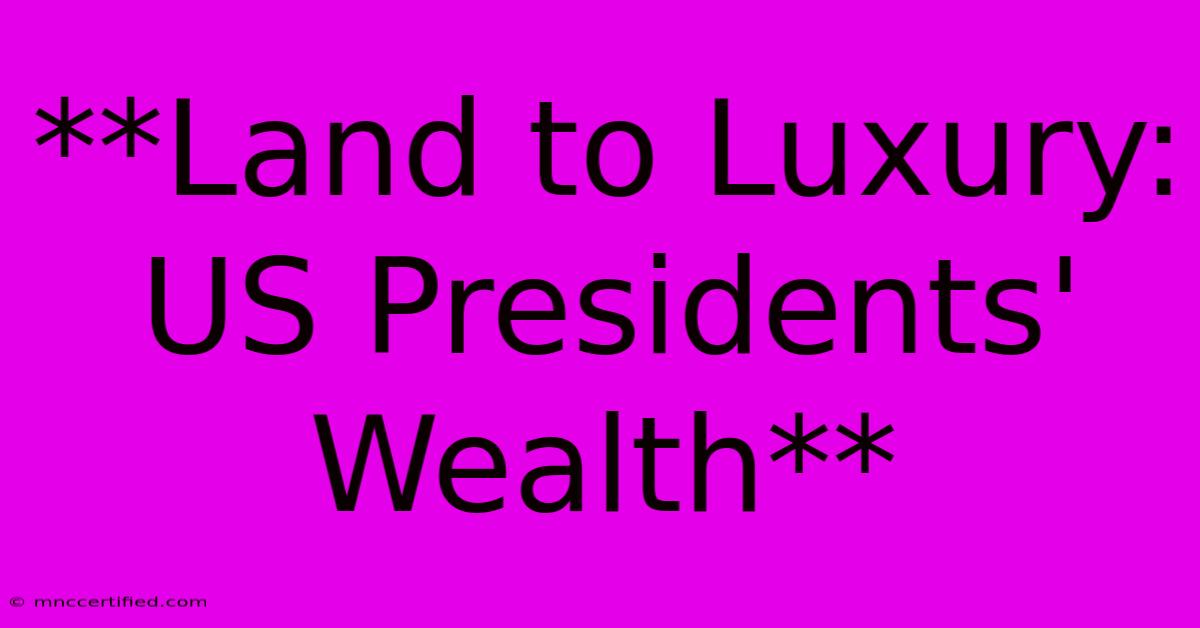**Land To Luxury: US Presidents' Wealth**

Table of Contents
Land to Luxury: US Presidents' Wealth – From Humble Beginnings to Fortunes
The office of the President of the United States is one of the most powerful positions in the world. While the role demands service and sacrifice, it's also a position that historically has been held by individuals with significant wealth. This raises the question: How has the wealth of US presidents evolved over time, and what does it reveal about American society?
From Farms to Fortunes: Early Presidents
The early presidents of the United States were largely landowners, with a focus on agriculture. George Washington, for example, owned a sprawling plantation in Virginia, while Thomas Jefferson was a successful farmer and slave owner. Their wealth was tied to land ownership and the exploitation of labor, reflecting the economic realities of the time.
However, as the nation industrialized and financial markets grew, so did the wealth of the presidents. Andrew Jackson, a wealthy planter and slave owner, exemplified the shift towards financial prowess.
The Rise of Big Business and the Gilded Age: A Shift in Presidential Wealth
The Gilded Age, from the late 19th century to the early 20th century, saw an explosion of industrialization and the emergence of powerful tycoons. This period also saw a notable increase in the wealth of presidents. Presidents like Grover Cleveland and William McKinley benefited from their connections to the burgeoning industrial sector.
Despite the growth in presidential wealth, it was still considered taboo to openly discuss the personal finances of the president. This changed in the 20th century, particularly with the rise of media scrutiny and the public's increased interest in presidential affairs.
The Modern Era: A Focus on Transparency and Disclosure
In the latter half of the 20th century, public awareness of presidential wealth increased significantly. The Watergate scandal, which led to Richard Nixon's resignation, emphasized the importance of transparency in government.
The modern era saw a move towards greater disclosure of presidential finances. The 1978 Ethics in Government Act required presidents to disclose their financial holdings and investments. This transparency has allowed the public to scrutinize the financial activities of their elected leaders.
The 21st Century: A New Era of Presidential Wealth
The 21st century has witnessed a significant shift in the sources of presidential wealth. While traditional industries like agriculture and manufacturing remain relevant, the modern economy is driven by technology, finance, and real estate.
Presidents like Bill Clinton, George W. Bush, Barack Obama, and Donald Trump have accumulated wealth through various means, including book deals, investments, and real estate holdings. This shift reflects the changing economic landscape and the growing influence of global finance in American society.
It's important to note that not all recent presidents have come from wealthy backgrounds. Jimmy Carter, for example, was a peanut farmer who was relatively modest in terms of wealth. Joe Biden's wealth, while substantial, is largely tied to his long career in government and his book deals.
What does the changing wealth of US presidents tell us?
The evolution of presidential wealth offers a fascinating glimpse into American society and the changing nature of the economy. It reflects the nation's transition from a primarily agrarian society to an increasingly globalized and technologically advanced one.
However, it also raises important questions about the influence of wealth on the political system. Does wealth give certain individuals an unfair advantage in seeking the highest office in the land? How can we ensure that the presidency remains accessible to individuals from diverse backgrounds and economic circumstances?
These questions will continue to be debated as the nation navigates the challenges of the 21st century. Understanding the history of presidential wealth can help us to better analyze the complex interplay between wealth, power, and public service in the United States.
Keyword Integration for SEO:
-
On-page SEO:
- Target keywords: US Presidents, Presidential Wealth, Wealth of US Presidents, Presidential Finances, Land Ownership, Industrialization, Gilded Age, Transparency, Disclosure, Modern Era, 21st Century, Economic Landscape, Global Finance, Wealth in Politics.
- Keyword density: Strategically placed keywords throughout the article, focusing on natural integration rather than stuffing.
- Heading structure: Clear and concise headings (h2, h3) to improve readability and structure.
- Bolding: Key terms and phrases are bolded to highlight important concepts and improve SEO visibility.
- Internal linking: Link to related content on your website or other high-quality sources to boost SEO and provide users with more information.
-
Off-page SEO:
- Backlinking: Reach out to relevant websites and publications to request backlinks to your article.
- Social media promotion: Share your article on social media platforms with relevant hashtags.
- Guest posting: Contribute articles to other websites and blogs to establish authority and drive traffic back to your website.
This comprehensive SEO strategy will help to improve your article's visibility and ranking in search results, ultimately driving more traffic to your website.

Thank you for visiting our website wich cover about **Land To Luxury: US Presidents' Wealth**. We hope the information provided has been useful to you. Feel free to contact us if you have any questions or need further assistance. See you next time and dont miss to bookmark.
Featured Posts
-
Millwall Vs Leeds Boss Sees X Factor In Whites
Nov 07, 2024
-
Direct Repair Programs Insurance Companies
Nov 07, 2024
-
Smiths Federal Cases Nearing Closure
Nov 07, 2024
-
Ivanka Trump Supports Donald In Blue Ensemble
Nov 07, 2024
-
Election Results Musk Emerges Victorious
Nov 07, 2024